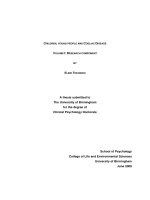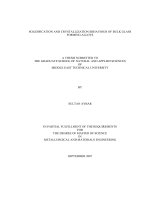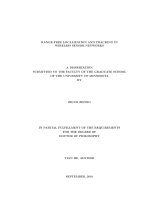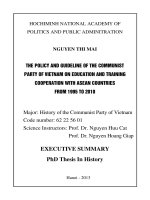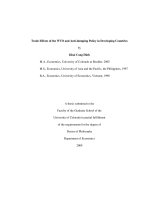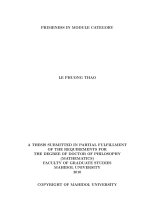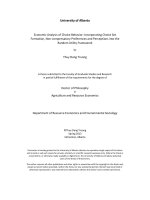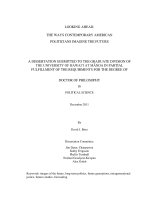PhD Thesis submitted to the Faculty of Economics at the University of Neuchâtel
Bạn đang xem bản rút gọn của tài liệu. Xem và tải ngay bản đầy đủ của tài liệu tại đây (5.57 MB, 198 trang )
Three essays on the economics of smoking
PhD Thesis submitted to the Faculty of Economics at the
University of Neuchâtel
by
Joachim Marti
Supervisor:
Claude Jeanrenaud, Professor of Economics, University of Neuchâtel
Members of the Committee:
Donald Kenkel, Professor of Economics, Cornell University
Milad Zarin, Professor of Economics, University of Neuchâtel
Peter Zweifel, Professor of Economics, University of Zurich
Defended in Neuchâtel, 19 January 2011
iii
Acknowledgments
The writing of a dissertation can be an isolating experience, yet it is obviously not
possible without the support of numerous people. These few words are intended to
thank them.
First of all, I would like to thank my supervisor, Professor Claude Jeanrenaud, for his
thoughtful guidance. His comments and high requirements allowed me to improve
significantly my scientific rigor. I am also grateful to Professors Donald Kenkel,
Milad Zarin and Peter Zweifel who have kindly accepted to serve in my dissertation
Committee. I particularly acknowledge them for their comments, remarks, and their
precious time.
I thank the University of Neuchâtel which provided me the resources to conduct
research effectively and which gave me the opportunity to work in a pleasant
environment. I also thank the Federal Office of Public Health and the Tobacco
Prevention Fund for the funding of some of the projects presented in this dissertation.
I would also like to thank Professors Claude Jeanrenaud, Milad Zarin and Jean-Marie
Grether for giving me teaching responsibilities. These experiences were very fruitful
and I had an immense pleasure to contribute a little to the building of the academic
background of Bachelor and Master Students.
I am also grateful to all my colleagues at the Institute for Research in Economics,
especially Sonia Pellegrini, Dimitri Kohler, and Sylvie Fueglister-Dousse who had
the difficult task to tolerate me and to laugh at my bad jokes.
I would like to thank all my friends, particularly Olivier, Lorin, Jody, Alain, Laurent,
Romain (2x), Vincent, Bertil, Thierry, Georges-Alain, all members of the fabulous
“Section Neuchâteloise de la Société Suisse des Etudiants de Zofingue”, and all other
great people I met during the essential hours spent at having good time.
My sincere gratitude goes to my parents, my brother Sébastien, my sister Aurélie, and
to Gaëlle, for their love, support and patience over the last few years.
Finally, I would like to dedicate this work to my Dad.
v
Executive summary
Each year, more than 9,000 people die from diseases attributable to smoking
in Switzerland. This corresponds to 15% of the total number of deaths per year.
According to the OECD/WHO report on the Swiss health system, tobacco use is the
leading risk factor for disease, as it accounted for 11.2% of total disability-adjusted
life years (DALYs) lost in the country in 2002. Intuitively, as human beings, our
primary reaction would be to consider these numbers per se as justifications for
intervention in the tobacco market, with a substantial reduction in tobacco
consumption as the objective. Yet, is any intervention justified in the economic
sense? If yes, what is the optimal level of intervention, and what measures are the
most effective and, as we must deal with limited resources, cost-effective? Many of
these questions remain unresolved. The economic approach benefits from
sophisticated analytical instruments, both theoretical and empirical, that have the
virtue of providing fairly objective insights into the decision to smoke.
This dissertation focuses on the influence of tobacco policies on smoking
behavior, on the perception of smoking risks of young individuals, and on the
valuation of smoking cessation treatments. It is divided into two main parts. In the
first part, I discuss the rationale of analyzing smoking decisions from an economic
perspective, based on the specificities of the product. I then briefly present the main
models of smoking decisions, and I review the recent literature on the “best-practice”
interventions aimed at reducing tobacco use, i.e., price increases, information,
advertising bans, smoking bans, and cessation support. The second part consists of
three empirical essays related to smoking decisions. The first essay sheds light on the
ability of tobacco control expenditures to influence individual smoking decisions. In
2007, in Switzerland, approximately 20 million francs, or 2.6 francs per capita, were
spent on non-price policy interventions aimed at reducing tobacco use in the
population. While I provide evidence that these resources were effective in increasing
the number of quitters, it seems likely that they did not have any significant influence
on smoking onset. Besides price increases, tobacco control measures implemented in
the last decade hardly influenced smoking participation among youths. Another
strategy that could potentially influence the behavior of this population is the
dissemination of proper deterrent messages. The second essay specifically looks at
the relative importance that young individuals put on the consequences of smoking. I
show that apart from lung cancer, reduced life expectancy, and cardiovascular
vii
diseases, youths are also concerned by more immediate consequences, such as a
reduction of physical capacity and sexual dysfunction. I also show that smoking
participation is negatively associated with the level of far-sightedness, defined as the
level of concern for long-term health risks. The last essay focuses on smoking
cessation. Smokers make repeated attempts to quit and are rarely successful, mainly
due to the negative effects of addiction, i.e., physical and psychological craving. One
way to improve the cessation rates is to increase the use in the population of an
appropriate smoking cessation support. To understand what drives the demand for
smoking cessation drugs and how smokers value their potential benefits and
disadvantages, I collected data on hypothetical choices and focused on treatment
efficacy, minor side effects, price, availability, and ability to prevent smokingcessation-associated weight intake. I was able to estimate willingness-to-pay for each
dimension and for improved medications as a whole and also to point out some
individual characteristics that determine the decisions to use such products.
Keywords: smoking, smoking initiation, smoking cessation, tobacco control, public
health, health behaviors, health economics, smoking cessation treatments, risk
perception, hazard models, discrete choice experiments, best-worst scaling.
viii
Table of contents
1
General introduction........................................................................................... 1
Part I ......................................................................................................... Background
2
Economics of smoking and public policy .......................................................... 7
2.1.
Introduction ................................................................................................... 7
2.2.
Theoretical framework .................................................................................. 9
2.3.
Market failures and rationale for a government intervention...................... 15
2.4.
Policies ........................................................................................................ 22
2.4.1.
Tobacco taxation ................................................................................. 22
2.4.2.
Information.......................................................................................... 30
2.4.3.
Advertising, and advertising bans ....................................................... 37
2.4.4.
Protection against passive smoking .................................................... 39
2.4.5.
Smoking cessation support.................................................................. 42
Appendix A: Successful cessation, education, and income .................................... 46
Part II ................................................................................................Empirical Essays
3 The impact of tobacco control expenditures on smoking initiation and
cessation ..................................................................................................................... 51
3.1.
Introduction ................................................................................................. 52
3.2.
Related work ............................................................................................... 54
3.3.
Tobacco control in Switzerland .................................................................. 56
3.4.
Empirical strategy ....................................................................................... 59
3.5.
Data ............................................................................................................. 67
3.6.
Descriptive statistics ................................................................................... 71
3.7.
Results ......................................................................................................... 75
3.8.
Discussion ................................................................................................... 84
Appendix A: Overview of tobacco control in Switzerland ..................................... 86
Appendix B: Kaplan-Meier hazard rates by region ................................................ 87
Appendix C: Cox model fit ..................................................................................... 88
4 Perception of smoking-related adverse effects among youths: a best-worst
scaling approach........................................................................................................ 89
4.1.
Introduction ................................................................................................. 90
4.2.
Background ................................................................................................. 92
4.3.
Method ........................................................................................................ 97
4.4.
Results ....................................................................................................... 103
ix
4.5.
Conclusion ................................................................................................ 110
Appendix A: Experimental design ........................................................................ 111
Appendix B: Sample characteristics ..................................................................... 112
Appendix C : Estimated relative importance across groups ................................. 114
Appendix D: Present orientation and alcohol use ................................................. 114
5 Assessing smokers' preferences for smoking cessation medications: A
discrete choice experiment ..................................................................................... 117
5.1.
Introduction ............................................................................................... 118
5.2.
Related work ............................................................................................. 120
5.3.
Framework for analysis ............................................................................. 123
5.4.
Data collection (DCE survey) ................................................................... 125
5.5.
Econometric analysis ................................................................................ 130
5.6.
Results ....................................................................................................... 136
5.7.
Discussion ................................................................................................. 148
Appendix A: Example of choice set ..................................................................... 150
Appendix B: Nested Logit and the IV parameter.................................................. 151
6
Concluding remarks ....................................................................................... 153
6.1.
Introductory part ....................................................................................... 153
6.2.
Empirical essays........................................................................................ 155
6.3.
Potential future projects ............................................................................ 161
x
List of Figures
Chapter 2
Figure 2.1: Optimal level of cigarette consumption - three perspectives.................... 17
Figure 2.2: Real price of cigarettes in Switzerland ..................................................... 23
Figure 2.3: International brand prices of a 20-unit pack, PPP .................................... 24
Figure 2.4: Tax as a health policy tool ........................................................................ 24
Figure 2.5: Tax and price increases in Switzerland .................................................... 25
Figure 2.6: Sales of hand-rolled cigarettes in Switzerland ......................................... 27
Chapter 3
Figure 3.1: Duration variables – spells and failures.................................................... 61
Figure 3.2: Reported years since quitting ................................................................... 64
Figure 3.3: Reported age at initiation.......................................................................... 64
Figure 3.4: Empirical Kaplan-Meier hazard and survival functions ........................... 72
Figure 3.5: Real price of cigarettes (1980-2007) ........................................................ 73
Figure 3.6: Estimated baseline hazard by region ........................................................ 81
Figure 3.7: Impact of tobacco control on smoking cessation rates ............................. 82
Chapter 4
Figure 4.1: Smoking prevalence by age (cohort of youth aged 14 in 2001) ............... 92
Figure 4.2: Initiation probability by age ..................................................................... 93
Figure 4.3: Comparison between Likert scale, ranking tasks and BWS ..................... 98
Figure 4.4: Example of a choice task ........................................................................ 100
Figure 4.5: Comparison between logit coefficients and B-W totals ......................... 105
Figure 4.6: Graphical representation of the underlying scale ................................... 105
Figure 4.7: Distribution of the level of concern by category .................................... 107
Chapter 5
Figure 5.1: Indifference curve in the attribute space................................................. 125
Figure 5.2: Nested logit tree structure ....................................................................... 132
Figure 5.3: Distributions of WTP ............................................................................. 146
Figure 5.4: Distributions of opt-out ASC.................................................................. 147
xi
List of Tables
Chapter 2
Table 2.1: Price of a cigarette pack (20 units) in Switzerland, 2009 .......................... 23
Table 2.2: Tax and price increases in Switzerland ...................................................... 25
Table 2.3: Spending for cigarettes as a share of household income ........................... 28
Table 2.4: Effectiveness of smoking cessation interventions ..................................... 43
Chapter 3
Table 3.1: Cost effectiveness of tobacco control interventions .................................. 56
Table 3.2: Selected list of tobacco control interventions ............................................ 57
Table 3.3: Analysis samples corresponding to years 1980-2007 ................................ 67
Table 3.4: Data example ............................................................................................. 70
Table 3.5: Individual characteristics ........................................................................... 73
Table 3.6: Per-capita tobacco control expenditures in the Swiss regions ................... 74
Table 3.7: Analysis of smoking prevalence (2001-2007) ........................................... 75
Table 3.8: Initiation analysis – Discrete time hazard models (logit) .......................... 77
Table 3.9: Initiation analysis – Continuous time hazard models (Cox) ...................... 77
Table 3.10: Cessation analysis – Discrete time hazard models (logit)........................ 79
Table 3.11: Cessation analysis – Continuous time hazard models (Cox) ................... 80
Table 3.12: Cessation models – Sensitivity analysis .................................................. 83
Chapter 4
Table 4.1: Final list of smoking-related negative effects ............................................ 99
Table 4.2: Data output example ................................................................................ 101
Table 4.3: MNL and RPL models and B-W total ..................................................... 104
Table 4.4: Estimated choice probabilities ................................................................. 106
Table 4.5: Association between level of concern and smoking status ...................... 108
Table 4.6: Eigenvalues .............................................................................................. 109
Table 4.7: Factor loadings......................................................................................... 109
Table 4.8: Far-sightedness, smoking, and drinking behavior ................................... 109
Chapter 5
Table 5.1: Published studies using DCE to value medical interventions .................. 121
Table 5.2: Attributes and levels ................................................................................ 128
Table 5.3: Description of the opt-out option ............................................................. 131
Table 5.4: Descriptive statistics (N=131) ................................................................. 137
Table 5.5: Estimation results – MNL and NL models .............................................. 140
Table 5.6: Estimation results - RPL models.............................................................. 141
Table 5.7: Estimation results – models with interactions ......................................... 142
Table 5.8: Average predicted opt-out probabilities. Four scenarios ......................... 143
Table 5.9: WTP estimates ......................................................................................... 144
Table 5.10: WTP estimates by income group ........................................................... 144
Table 5.11: Determinants of the intrinsic propensity to opt-out (OLS) .................... 147
xii
“Tobacco is a dirty weed,
I like it.
It satisfies no normal need,
I like it.
It makes you thin, it makes you lean,
It takes the hair right off your bean.
It's the worst darn stuff I've ever seen.
I like it.”
Graham Lee Hemminger, 1915
xiii
1
General introduction
Life is a succession of choices that can have unexpectedly severe
consequences. Making informed choices involves being properly informed of the
consequences of these choices, even if they may occur only in the distant future. In
addition, uncertainty often plays a preponderant role in decisions, especially those
related to health. In this regard, smoking is an interesting, and somewhat unexpected,
consumption decision made by individuals. Indeed, deciding to consume an
expensive product, even in small quantities, that can potentially kill you and harm
others’ health (including relatives) does not seem trivial. Thus the question that comes
to mind is obvious: why do people smoke? Are the immediate rewards provided by
consumption so important that they outweigh all perceived costs, including potential
future adverse consequences? If this is the case, is it true for any consumption, or only
for the initial decision, which subsequently leads to excessive levels of consumption
due to addiction? Another explanation lies in the unpredictability of the
consequences, significantly reinforced by the important time dimension (indeed, you
only potentially will get lung cancer only 50 years after initiation). The corollary is
the notion of risk, which can be ignored, inaccurately assessed, or even denied by
individuals. Making wise trade-offs between immediate gratification and future,
uncertain, and not well-understood consequences is obviously not an easy task, at
least for the quarter of the Swiss population that is currently smoking. Economics, as
the science of choices, can shed some light on the reasons that push people to take
such risky decisions. In his article “Economics of tobacco: myths and realities”
Kenneth Warner (2000) concludes with the following sentence: “If the tobacco
control community can develop a sophisticated appreciation of the essence of tobacco
economics, and convey that understanding to public decision makers, perhaps we can
force the issue of tobacco back where it properly belongs, in the domain of public
health.” This assertion synthesizes the main motivations that prompted me to do
research in the field of tobacco economics: applying sophisticated methods rooted in
economic theory to a concrete and complex public health issue and developing my
ability to convey sound messages to decision makers.
Each year, more than 9,000 people die from diseases attributable to smoking
in Switzerland. This corresponds to 15% of the total number of deaths per year.
According to the OECD/WHO report on the Swiss health system, tobacco use is the
leading risk factor for disease, as it accounted for 11.2% of total disability-adjusted
life years (DALYs) lost in the country in 2002. Intuitively, as human beings, our
1
primary reaction would be to consider these numbers per se as justifications for
intervention in the tobacco market, with a substantial reduction in tobacco
consumption as the objective. Yet, is any intervention justified in the economic
sense? If yes, what is the optimal level of intervention, and what measures are the
most effective and, as we must deal with limited resources, cost-effective? Many of
these questions remain unresolved. The economic approach benefits from
sophisticated analytical instruments, both theoretical and empirical, that have the
virtue of providing fairly objective insights into the decision to smoke.
The Federal Office of Public Health (FOPH), in its objectives included in the
2008-2012 “National Tobacco Program,” targets a 23% prevalence rate in the general
population by the end of 2012; the actual smoking participation rate is currently
approximately 27%. To achieve this goal and to ensure that the proportion of smokers
does not concentrate more in the most deprived classes of the population, careful
measures must be implemented and a good understanding of smoking decisions must
be achieved. It is crucial for public health decision makers to rely on scientific
findings to make informed decisions, to implement effective policies, and to achieve
goals in terms of improved health in the population. Despite the important literature
related to tobacco use and tobacco control in the fields of public health and health
economics, many issues remain unresolved and much research needs to be done to
most efficiently curb the tobacco epidemic. Some issues directly relate to the behavior
of individuals, i.e., to the determinants of their consumption decisions. Other issues
relate to the extent to which interventions should be implemented to influence
individual decisions, i.e., externalities, a lack of information, or even psychological
issues that justify interventions. Finally, if a desired level of intervention or a stated
objective in terms of a reduction of the prevalence of a risky behavior in the
population is determined, also considering equity issues, economics allows evaluating
the available policies and then informing policy makers on a sound allocation of
resources.
This dissertation delivers novel insights on the influence of tobacco policies
on smoking behavior, on the perception of smoking risks of young individuals, and on
the valuation of smoking cessation treatments. It is divided into two main parts. The
first part sets the scene. I discuss the rationale of analyzing smoking decisions from
an economic perspective, based on the specificities of the product. I then briefly
present the main models of smoking decisions, and I review the recent literature on
the “best-practice” interventions aimed at reducing tobacco use, i.e., price increases,
2
information, advertising bans, smoking bans, and cessation support. The second part
consists of three empirical essays related to smoking decisions.
The first essay (Chapter 3) sheds light on the ability of tobacco control
expenditures to influence individual smoking decisions. In 2007, in Switzerland,
approximately 20 million francs, or 2.6 francs per capita, were spent on non-price
policy interventions aimed at reducing tobacco use in the population. While I provide
evidence that these resources were effective in increasing the number of quitters, it
seems likely that they did not have a significant influence on smoking onset. Besides
price increases, tobacco control measures implemented in the last decade hardly
influenced smoking participation among youths. Another strategy that could
potentially influence the behavior of this at-risk population is the dissemination of
proper deterrent messages. The second essay (Chapter 4) specifically looks at the
relative importance that young individuals put on the consequences of smoking. I
show that apart from lung cancer, reduced life expectancy, and cardiovascular
diseases, youths are also concerned by more immediate consequences, such as a
reduction of physical capacity and sexual dysfunction. I also show that smoking
participation is negatively associated with the level of far-sightedness, defined as the
level of concern for long-term health risks. Chapter 5 focuses on smoking cessation.
Smokers make repeated attempts to quit and are rarely successful, mainly due to the
negative effects of addiction, i.e., physical (withdrawal) and psychological craving.
One way to improve the cessation rates is to increase the use in the population of an
appropriate smoking cessation support. To understand what drives the demand for
smoking cessation drugs and how smokers value their potential benefits and
disadvantages, I collected data on hypothetical choices and focused on treatment
efficacy, minor side effects, price, availability, and ability to prevent smokingcessation-associated weight intake. I was able to estimate willingness-to-pay for each
dimension and for improved medications as a whole and also to point out some
individual characteristics that determine the decisions to use such products.
I obviously do not pretend to answer all relevant questions that remain open
in the field of smoking decisions and its determinants. However, I believe that this
work adds to the existing knowledge on smoking decisions and on the
appropriateness and effectiveness of interventions to curb smoking.
3
Part I
Background
In this part, I first define what makes cigarettes such a particular commodity. Then,
after giving an overview of the theoretical framework within which the consumption
of addictive goods is analyzed, I present the various tobacco-related market failures,
and discuss the extent to which governments should intervene in individual smoking
decisions. Finally, I review the available policy instruments intended to reduce
smoking, their efficacy, and provide some figures related to Switzerland.
5
2
Economics of smoking and public policy
2.1.
Introduction
Cigarettes have particular characteristics that influence the analytical
framework within which smoking decisions are analyzed. If we aim to understand the
rationale for an economic analysis of smoking decisions, it is essential that we
identify these particularities. In short, cigarettes generate adverse health consequences
for users and exposed non-users (most of which manifest in the distant future),
cigarettes are addictive, and consumption mostly begins during childhood.
It is well known and has been widely documented that even occasional and
moderate tobacco use is harmful to health. In other words, smokers cannot achieve a
“safe” level of cigarette consumption. The only way to avoid smoking-related health
consequences is abstinence and the avoidance of exposure to the smoke of others.
Smoking is a major risk factor associated with a large number of diseases, including
pulmonary complications (chronic obstructive pulmonary disease, bronchitis,
influenza, emphysema, pneumonia, lung cancer), cardiovascular diseases (acute
myocardial infarction, stroke), and various other cancers (kidney, mouth, stomach,
pancreas, larynx). In addition to causing serious chronic conditions, smoking also has
non-lethal health consequences, including the reduction of physical capacity
(shortness of breath), sexual impairment, and impact on appearance (teeth, skin). It
has been estimated that a lifelong regular smoker will die about 14 years earlier, on
average, than a non-smoker with the same characteristics (CDC 2002). Although
smoking has some immediate impacts on health, the most serious health
consequences manifest late in life. Because of this lag between consumption and its
associated risks, individuals naturally do not put much weight on these consequences
in making decisions regarding smoking. In economic terms, they are said to discount
the future quite heavily, especially while young. Moreover, individuals are not fully
aware of the health risks associated with smoking. Some have been extensively
communicated, but others, such as COPD, are much less well known. This potential
lack of awareness, the over-optimism of individuals who think that they cannot be
personally affected, and the time lag between consumption and the impact on health
suggest that individuals do not fully incorporate the health consequences of smoking
in their decisions. Furthermore, smoking can have adverse health consequences for
non-smokers through environmental tobacco smoke (second-hand smoke).
7
According to economic theory, a good is addictive if its consumption during a
particular period depends strongly on past consumption patterns. Cigarette addiction
is both physical (because of the impact of nicotine on the brain) and psychological (as
associated with gesture, ritual, habits). Three concepts are used to characterize
addiction: tolerance, reinforcement and withdrawal. When an individual develops
tolerance for a substance, the higher the cumulative past consumption, the less utility
is derived from a given level of present consumption. In other words, the body
becomes used to the drug, and an increasingly larger quantity is required to satisfy the
individual1. The notion of reinforcement is directly linked to the benefits of
consumption (pleasure, the effects of nicotine, psycho-social effects, the gesture, the
“ritual”) and the costs avoided (one smokes to avoid cravings). Withdrawal is the
body’s reaction to a lack of nicotine after the cessation or reduction of consumption.
The associated symptoms include nausea, high blood pressure, abnormal heart rate,
irritability, nervousness, and anxiety.
Finally, the fact that smoking initiation mostly occurs before the age of 20 has
important implications for the analysis of smoking decisions2. Individuals in this age
group are more short-sighted, are often less informed, and feel the need to be
accepted by their peers. Young individuals are usually not fully aware of the addictive
potential of cigarettes when they start smoking and are overoptimistic about their
ability to quit. They thus often regret their choice later in life.
In summary, smoking is harmful to both direct and indirect smokers (i.e.,
those who are exposed to “second-hand” smoke). Furthermore, it is essential that we
consider the time dimension if we aim to understand smoking decisions, both in
relation to the occurrence of health consequences and to the development of addiction
over time. In the next section, I describe smoking decisions from an economic
perspective, relying on the specific character of this particular commodity as
described above.
1
In the case of tobacco use, consumption increases only up to a certain level and then remains stable
2
More than 80% of current smokers in Switzerland started before 20 years old, and almost no initiations are observed
after the age of 25 (see Chapter 3)
8
2.2.
Theoretical framework
The specific qualities of cigarettes as a consumer good (or rather “bad”) lead
us to extend the standard microeconomic framework of individual behavior. When
they face the decision to consume such goods, individuals are assumed to consider the
immediate benefits that they draw from consumption in tandem with the monetary
(and non-monetary) present and future costs of consumption. The dynamic and
temporal dimension is central because of the addictive nature of the good and because
of the harmful dimension of cigarette smoking, the consequences of which mostly
manifest in the distant future. In his conceptual framework for analyzing smoking
decisions, an economist should then take into account the past (addiction, habit
formation), the present (price and other non-monetary costs), and the future (the
potential disutility associated with smoking-related health risks, the risk of becoming
addicted, and the future effects of addiction). Given that the consumption decisions of
an individual who has already experienced cigarettes are likely to be influenced by its
addictiveness, it is reasonable to separately analyze the decisions of those who have
never smoked cigarettes. It also makes sense to distinguish between current and past
users. Thus, we can define smoking decisions as the decision to start smoking (new
users), to change the quantity consumed or to quit (current users), and to relapse
(former users).
The tobacco history of an individual is better understood when divided into
several phases. A young individual will look for immediate reward, has low selfcontrol, and has limited information. Youths perceive cigarette consumption as an
opportunity to rebel, to show that they belong to a group, or to simply look more
mature. Their decision to smoke is likely to be influenced by their peers and will
usually not be very costly (at least in monetary terms) because experimentation with
cigarette smoking is often not related to the purchase of the product. In this age group,
other immediate costs of consumption include bypassing family rules and laws
regarding minimum purchase age. Young individuals are likely to be less aware than
adults about the health risks associated with smoking, and even if they know some of
the risks, they are prone to put little weight on those that are distant in time. This lack
of awareness is also related to the addictive potential of the product, which is often
deemphasized, leading to over-optimism about future personal smoking status. Once
an individual has smoked his first cigarette, he starts to accumulate “addictive capital”
that will have a significant impact on his future decisions. Both the effects of nicotine
on the body and the psychological gratification associated with smoking
reinforcement have a positive impact on utility. Moreover, at least some of the
9
benefits of consumption come from avoiding the costs that would be associated with
reduced consumption. With this in mind, the smoker smokes at least partly to avoid
disutility rather than to increase utility. Moreover, the greater the addictive stock, the
more the individual will have to consume during the next period to achieve the same
level of utility. These considerations have important consequences for the smoking
decisions of current and past smokers. Because the marginal utility of cigarettes
increases with the addictive capital, new smokers will progressively increase their
level of consumption. Furthermore, when a smoker decides whether or not to quit, the
perceived benefits of quitting are often offset by the huge perceived withdrawal costs.
After an attempt to quit, the withdrawal costs experienced are such that former
smokers often relapse. When a smoker ages, two effects compete, and the resulting
effect on smoking behavior is unclear. First, long-term smokers have accumulated an
important addictive stock, and thus, the associated costs of quitting might then be
very important for them. However, as they become older, the health risks associated
with smoking become imminent and therefore may have a larger influence on
consumption decisions.
Economic models of addiction
Here I present some models of individual behavior that incorporate
considerations related to addiction (see also Chaloupka and Warner 2000). In these
models, individuals are said to be myopic, fully rational or imperfectly rational.
Myopic individuals know that smoking is addictive but do not anticipate the
consequences of addiction when they make smoking-related decisions. Fully rational
individuals are assumed to be very aware of the future implications of addiction and
to incorporate those considerations into their decisions. This point of view, mostly
developed by Becker and Murphy (1988), implies perfect foresight. Imperfectly
rational individuals have preferences that are not consistent over time.
When we model the demand function for a particular good, the standard
method involves defining a utility function that depends on the current consumption
of the good of interest ( Ct ) and on a composite good that reflects all other
consumption ( Yt ). The utility function at time t is then
Ut = f(Ct ,Yt )
(2.1)
The consumer is assumed to maximize this utility function subject to income
constraints such that we attain a demand function that depends on current price (and
10
other usual factors). This model of consumption is not well suited to addictive goods
because it does not incorporate the idea that past consumption has an influence on
present consumption, which in turn influences future consumption. The concept of
habit formation has been introduced by several authors, including Pollak (1970). The
idea is to include elements of past consumption in the utility function. In these
models, referred as myopic addiction models, a good is addictive if past consumption
increases current consumption. Past consumption is summarized in a stock of
addictive capital ( St ) that depreciates over time, at rate δ .
Ut = f(Ct ,St ,Yt )
(2.2)
with
St = Ct-1 +(1 - δ)St-1
(2.3)
In addition to conventional current factors, the resulting demand function includes
past consumption. In these models, tastes are allowed to change over time in relation
to past consumption. However, it is assumed that individuals do not take into account
the future implications of their addiction in their current consumption decisions.
Whereas the future consequences of consumption are ignored in myopic
models, individuals maximize their lifetime utility in the rational addiction model
(Becker and Murphy 1988), taking into account the correlations between past,
current, and future consumption. The idea of “adjacent complementarity” is
introduced, in which the same goods consumed in two adjacent periods are
complements. In this framework, the rational smoker knows that he will become
addicted and is fully aware of all of the consequences of his consumption. Demand is
therefore assumed to depend on past and future anticipated price and on past and
future consumption3. Chaloupka (1991) presents the rational addiction model in an
original way. He defines three elements that are included in the utility function: health
capital, Ht , euphoria generated by the consumption of the addictive good, Et , and a
composite good, Yt :
Ut = f(Ht ,Et ,Yt )
(2.4)
In the model, Et is assumed to depend on the addictive stock S t , which depreciates
over time (see (2.3)), and on current consumption Ct :
3
The structural form of the model could be C = β + β P + β P + δβ P + β C + δβ C , with
t
0
1 t
2 t-1
2 t+1
3 t-1
3 t+1
discount factor reflecting the rate of time preferences.
11
δ , the
